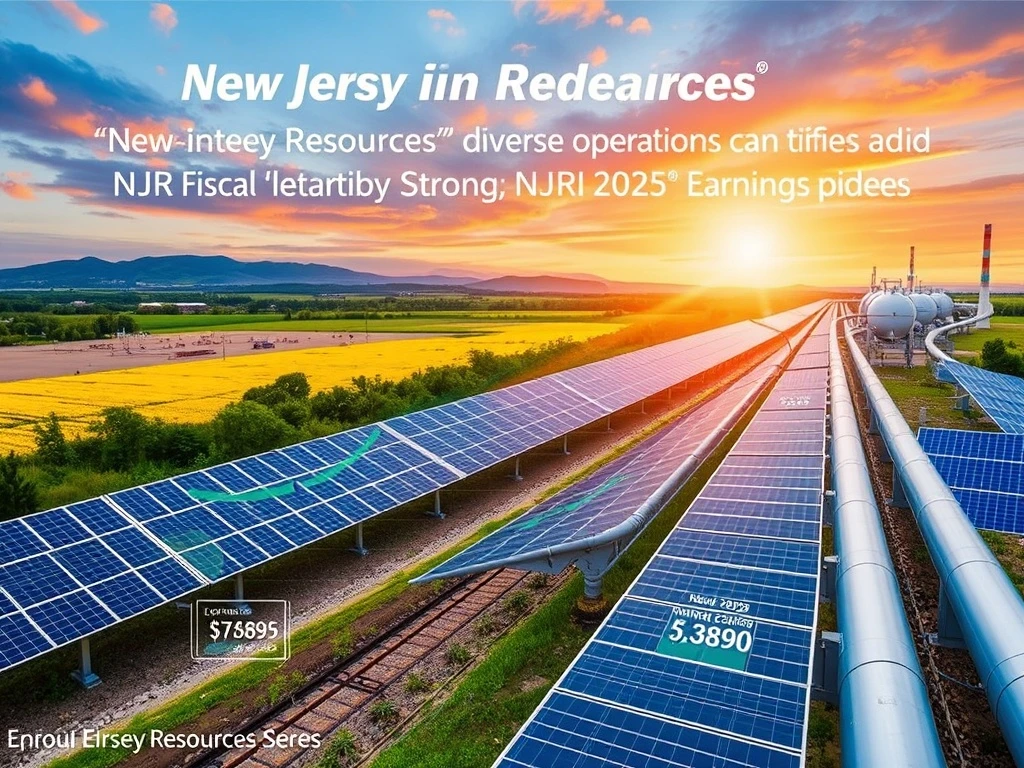For investors and industry observers, understanding a company’s financial health is paramount. New Jersey Resources (NJR) recently unveiled its robust NJR Fiscal 2025 Earnings for the third quarter, signaling a period of significant operational strength and strategic success. This report offers a clear picture of the company’s performance, highlighting its diverse business model and commitment to sustained value for shareowners.
NJR Fiscal 2025 Earnings Overview
New Jersey Resources Corporation (NYSE: NJR) released its financial and operating results for the fiscal 2025 third quarter, ending June 30, 2025. The company demonstrated notable improvements across key metrics. Specifically, consolidated net financial earnings (NFE), a non-GAAP measure, reached $6.2 million, or $0.06 per share. This contrasts sharply with a net financial loss of $(8.9) million, or $(0.09) per share, in the prior year’s third quarter.
While the consolidated net loss for the third quarter was $(15.1) million, or $(0.15) per share, compared to $(11.6) million in fiscal 2024, the year-to-date figures present a much brighter outlook. Year-to-date net income totaled an impressive $320.6 million, or $3.20 per share. This marks a substantial increase from $198.6 million, or $2.02 per share, reported for the same period in fiscal 2024. Similarly, year-to-date NFE climbed to $313.4 million, or $3.13 per share, up from $202.1 million, or $2.05 per share, in the previous fiscal year.
Raising the Bar: Fiscal 2025 Outlook for NJR
Confidence in the company’s performance is evident in its updated fiscal 2025 outlook. NJR has raised the lower end of its net financial earnings per share (NFEPS) guidance. The new range is now $3.20 to $3.30, an increase of $0.05 from the prior $3.15 to $3.30 range. This positive adjustment reflects strong operational performance and strategic gains.
Furthermore, the company maintains its long-term NFEPS growth target of 7 to 9 percent. This target is based on a fiscal 2025 NFEPS target of $2.83 per share. The revised guidance is higher than this long-term target, primarily due to the significant gain from the sale of NJR’s residential solar portfolio and robust contributions from Energy Services.
Strategic Growth Driving NJR Fiscal 2025 Earnings
Steve Westhoven, President and CEO of New Jersey Resources, emphasized the company’s consistent execution. He highlighted their strategy to drive stable growth through a diversified business model. Westhoven noted that the third-quarter results underscore the strength of their complementary portfolio. They also reaffirm the critical role of their physical infrastructure in delivering sustained value. The improvement in net financial earnings and the decision to raise guidance reflect the operational resilience. Management remains confident in achieving long-term growth targets and delivering consistent performance for shareowners.
Deep Dive into Segment Performance
Each of NJR’s business segments contributed to the overall NJR Fiscal 2025 Earnings picture:
- New Jersey Natural Gas (NJNG): NJNG reported a significant turnaround, with third-quarter NFE of $10.1 million, a strong improvement from a net financial loss of $(6.1) million in the prior year. Year-to-date NFE reached $221.5 million, up from $152.4 million. This increase primarily stemmed from higher utility gross margin, driven by NJNG’s recent base rate case settlement. NJNG now serves approximately 588,000 customers and continues its Infrastructure Investment Program (IIP), spending $24.0 million year-to-date to enhance safety and reliability.
- Clean Energy Ventures (CEV): CEV reported a third-quarter net financial loss of $(6.9) million, consistent with the previous year. However, year-to-date NFE totaled $37.3 million, a substantial improvement from a loss of $(1.8) million. This increase was largely due to the gain from selling its residential solar portfolio. CEV added 32.1 megawatts (MW) of commercial solar capacity during the first nine months, reaching approximately 418MW in service.
- Storage and Transportation: This segment saw increased NFE, reporting $5.9 million in Q3 (up from $4.1 million) and $13.9 million year-to-date (up from $9.8 million). The growth was mainly due to higher operating revenues at Leaf River Energy Center. Adelphia also reached a settlement in principle for its rate case, which will be filed with FERC soon.
- Energy Services: Energy Services reported a third-quarter net financial loss of $(3.7) million and year-to-date NFE of $39.4 million. The year-to-date NFE decreased compared to the prior year, mainly due to lower contributions from Asset Management Agreements signed in December 2020.
- Home Services and Other Operations: This segment reported third-quarter NFE of $0.5 million and year-to-date NFE of $0.4 million. Higher installation and service contract revenue for the year-to-date period was offset by increased operating and maintenance expenses.
Financial Strength and Future Investments
New Jersey Resources remains committed to maintaining a robust financial profile. Capital expenditures during the first nine months of fiscal 2025 reached $456.8 million, including accruals. This represents an increase from $396.5 million in the same period of fiscal 2024. Higher expenditures at NJNG and CEV primarily drove this increase, supporting ongoing infrastructure enhancements and clean energy projects.
Cash flows from operations also demonstrated strength, totaling $385.2 million during the first nine months of fiscal 2025. This compares favorably to $362.9 million in the prior year. The improvement primarily reflects the increase in base rates at NJNG and positive changes in working capital components. These strong cash flows provide a solid foundation for future investments and shareholder returns.
Understanding Non-GAAP Financial Measures
NJR’s financial reports include non-GAAP financial measures like Net Financial Earnings (NFE) and utility gross margin. NFE helps investors understand core operating performance by excluding certain volatile items. These include unrealized gains or losses on derivative instruments related to unregulated subsidiaries and specific realized gains and losses on natural gas derivatives. Management believes NFE provides a clearer view of the company’s business model. It offers transparency and enables better period-to-period comparability of financial performance.
Utility gross margin for New Jersey Natural Gas is defined as operating revenues minus natural gas purchases, sales tax, and regulatory rider expense. This measure provides a meaningful basis for evaluating utility operations because natural gas costs, sales tax, and regulatory rider expenses are passed through to customers, thus having no impact on utility gross margin. These non-GAAP measures supplement GAAP results, offering a more complete understanding of NJR’s performance.
In conclusion, New Jersey Resources’ fiscal 2025 third-quarter results underscore the effectiveness of its diversified strategy. The strong year-to-date performance, coupled with raised guidance for NJR Fiscal 2025 Earnings, positions the company for continued success. NJR’s commitment to infrastructure investment, clean energy, and customer service reinforces its long-term growth prospects in the evolving energy landscape.
Frequently Asked Questions (FAQs)
Q1: What are the key highlights of NJR’s Fiscal 2025 Third-Quarter Results?
A1: New Jersey Resources reported a significant improvement in Net Financial Earnings (NFE) for Q3 2025, reaching $6.2 million compared to a loss in the prior year. Year-to-date NFE also saw substantial growth, totaling $313.4 million, up from $202.1 million in fiscal 2024. The company also raised the lower end of its fiscal 2025 NFEPS guidance.
Q2: What is ‘Net Financial Earnings’ (NFE) and why does NJR use it?
A2: NFE is a non-GAAP financial measure used by NJR to provide a clearer view of its core operating performance. It excludes unrealized gains or losses on certain derivative instruments and specific realized gains and losses related to natural gas inventory. Management believes NFE offers a more accurate reflection of the company’s business model and improves period-to-period comparability by removing short-term market volatility.
Q3: How did New Jersey Natural Gas (NJNG) contribute to the NJR Fiscal 2025 Earnings?
A3: New Jersey Natural Gas (NJNG) was a strong performer, reporting $10.1 million in NFE for Q3 2025 and $221.5 million year-to-date. This increase was primarily driven by higher utility gross margin, a direct result of NJNG’s recent base rate case settlement. NJNG continues to expand its customer base and invest in infrastructure improvements.
Q4: What is the updated outlook for NJR’s fiscal 2025 NFEPS guidance?
A4: NJR has raised the lower end of its fiscal 2025 NFEPS guidance range by $0.05, moving it to $3.20 to $3.30. This reflects confidence in the company’s ongoing performance, bolstered by gains from the sale of its residential solar portfolio and strong results from Energy Services. NJR maintains its long-term NFEPS growth target of 7 to 9 percent.
Q5: What were NJR’s capital expenditures and cash flows for the first nine months of fiscal 2025?
A5: For the first nine months of fiscal 2025, NJR’s capital expenditures were $456.8 million, an increase from the previous year, driven by investments in NJNG and Clean Energy Ventures. Cash flows from operations also increased to $385.2 million, demonstrating the company’s strong financial health and ability to fund future growth initiatives.
























